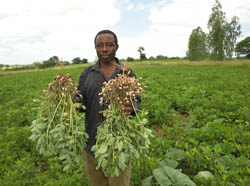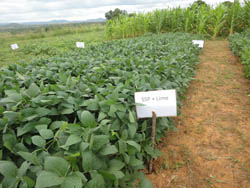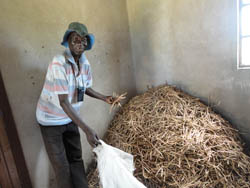When the N2Africa project was launched in Mudzi district in the 2010/11 season, most farmers and local authorities were very skeptical of the concept of biological nitrogen fixation. Farmers who have stayed in the district for over 20 years argued that growing soyabeans, common beans, groundnuts and cowpeas intensively in the area would not be successful since Mudzi lies in natural farming region IV which has low agro-ecological potential largely due to scarce and erratic rainfall. According to the farmers, the only crop that thrived under these arid conditions is groundnuts although the yields were below 0.75 t/ha. Rainfall in the district is very erratic and variable with a mean annual of 450 mm. Smallholder farmers in this district usually have food sufficient for mostly three months and rely on food handouts from food-for-work programs. The use of rudimentary farming practices on the increasingly nutrient depleted soils has seen maize yields falling way below 0.5 t/ha.
When farmers were enrolled in the project for the 2011/12 season, their hope was that they would access free inputs, an affliction which has become quite notable among most smallholder farmers in Zimbabwe. The farmers believed that the 1 kg seed packs that were given to follower farmers fell way below their expectation. This is despite the fact that they were made aware of the objectives of the N2Africa project through training. Moreover, farmers could not believe their ‘ears and eyes’ when they heard Byron Zamasiya, training them on farming as a business and collective marketing. Although he reiterated the need for farmers to move from ‘farming to agriculture’, the farmers in Mudzi still viewed the project skeptically. Traditionally, the farmers struggled to access the right inputs of improved legume seeds and fertilizers in reasonable proximity to their farm. Results from the N2Africa and IFAD baseline for Zimbabwe show that, smallholder farmers do not use certified legume seeds from agro-dealers. A large proportion of the farmers cite the lack of cash/credit to pay for the inputs due to their inability to sell their harvest in remunerative markets. Perennially, they are loss makers as their crop production costs outweigh their revenue from the sale of surplus produce. One lingering question in the minds of the farmers was whether the project would be able to improve soil fertility through biological nitrogen fixation, reduce production expenditures and improve farmers’ income through linking them to remunerative markets. As one farmer, Mrs Makanjera put it across, ‘will these dry bones live again?’
 |
|
|
Mr. Mike Nyamukondiwa (Mudzi) showing two groundnut plants with different numbers of pods, on the right he is holding Natal Common cultivated with SSP and Gypsum |
Mr. Katsande showing off his cowpea harvest (Mudzi district) |
It is against this gloomy backdrop that a field day was held at Mr Nyamukondiwa’s homestead in Ward 12. In the 2010/11 season, he participated in the collective marketing that saw the group dispose 2.9 tonnes of shelled groundnuts at $780/tonne. During the 2011/12 season, Mr Nyamukondiwa is participating in the N2Africa project as a groundnuts seed producer. He was allocated 10 kg of seed (certified Natal Common variety), and gypsum to produce groundnuts for onward buying by the project. Apart from the N2Africa seed multiplication plot, the farmer also allocated 5 ha of his land to groundnuts. In his plots, he used uncertified seed of a local variety known as ‘Kasawaya’ and he did not apply single super phosphate or gyspum.
 |
 |
|
Agronomy trials on the fields of Mrs Chaparadza visited during field day in Guruve district |
Agritex Field Officer Mr. Kahiya and District Administrator Mr. Mapungwana from Hwedza district handing over a knapsack sprayer to Mrs. Eva Mufanebadza |
On the 9th of March 2012, all roads in Mudzi’s ward 12, converged at Nyamukondiwa’s homestead. A total of 385 people attended the field day. Of these 385, 35 were stakeholders from the local authorities, agricultural extension officers from neighboring wards, NGO representatives, the Rural District Council chairman and local ward councilors, District Youth coordinator, Social Welfare department, the District Administrator and traditional leaders. In addition to these invited guests, three members of parliament for Mudzi constituency namely Mr Nhavaya, Mr Kachepa and Mrs Katsande attended the event. Drama unfolded in the seed multiplication plot after the farmer had finished explaining to the guests how he grew the crop. Many questions were raised and most of them were centered on use of and role of inoculants, fertilizers and how biological nitrogen fixation could help a farmer household improving household food security and income. The N2Africa and the IFAD Liaison Officers took turns to respond to the questions. However, the session on questions came to a complete halt when the District Administrator asked to count the number of seeds which the groundnuts plant had. Several plants were randomly uprooted from the seed multiplication plot and the minimum number of unshelled nuts per plant was 180 while the maximum was 210. The three members of parliament took turns to meticulously verify the seed counts and they confirmed the counts. However the groundnut plants from the farmer’s own field had at most 30 unshelled nuts. It was all smiles as the guests gave a clapping ovation to the IFAD and N2Africa Liaison Officers. Thereafter, they were presented with a goat by the farmers for their contribution to bringing the dry bones to life. The smallholder farmers saw it first-hand that use of certified groundnuts seeds and gypsum fertilizer has a very positive effect on yield. The farmers also learned that for them to realize profit from their crop enterprises, they need to grow crops that are wanted by the market using the lowest cost possible technology available such as nitrogen fixing legumes. A testimonial by one farmer, Mr Masuku who participated in IFAD led collective marketing in the 2010/11 season reiterated that legumes such as groundnuts are more profitable to grow as they fetch higher prices than maize. And indeed farmers in the wards involved have expanded their land areas under groundnut as compared to last season. At the close of the field day, two Members of Parliament, Mr Kachepa and Mrs Katsande, requested the CIAT team (N2Africa and IFAD officers) to bring the project to their constituencies in the 2012/13 season. They pledged to fund the purchase of the inputs which will be used in the demonstration plots. Surely, the dry bones had become flesh again!
Byron Zamasiya, Isaac Chabata and Nelson Mango

